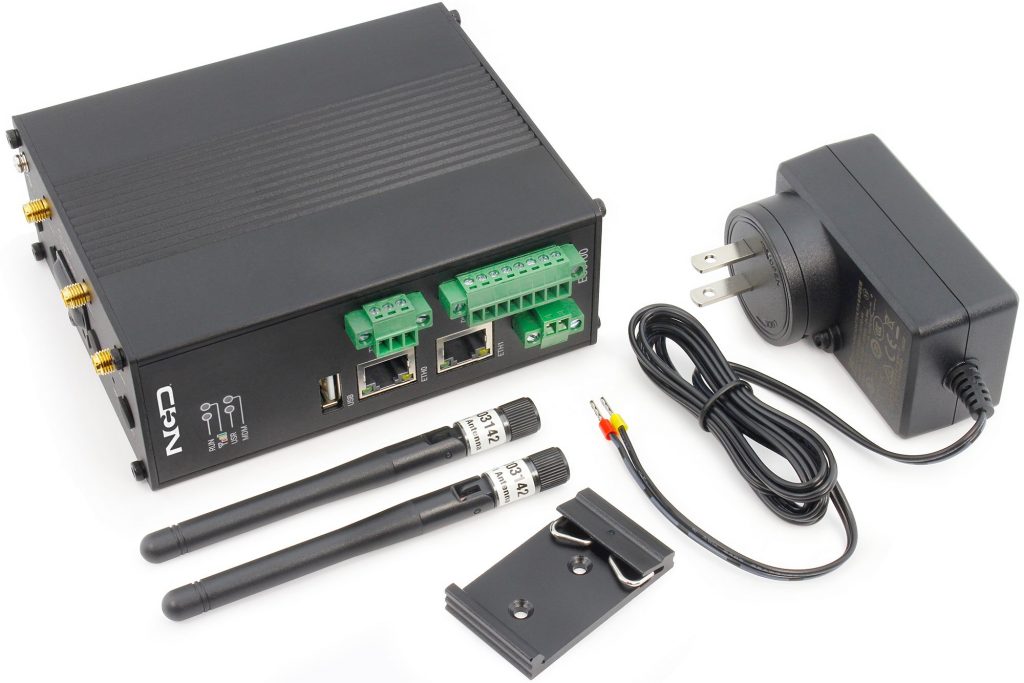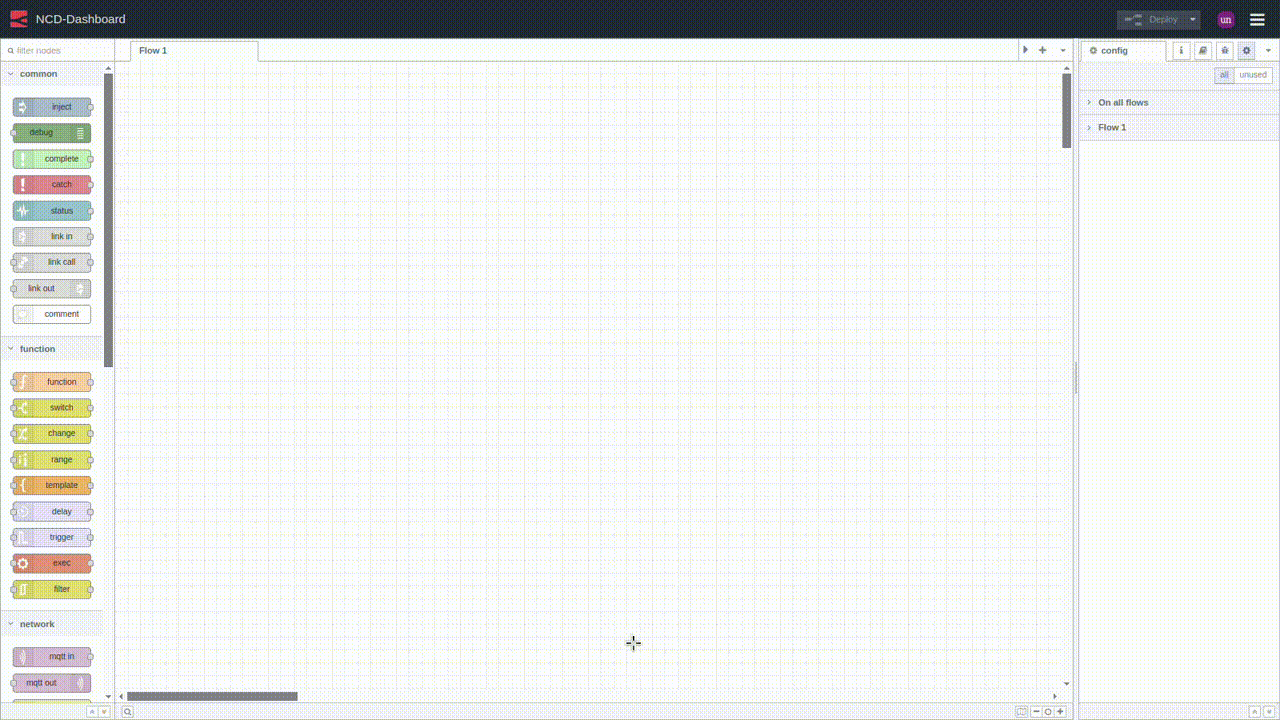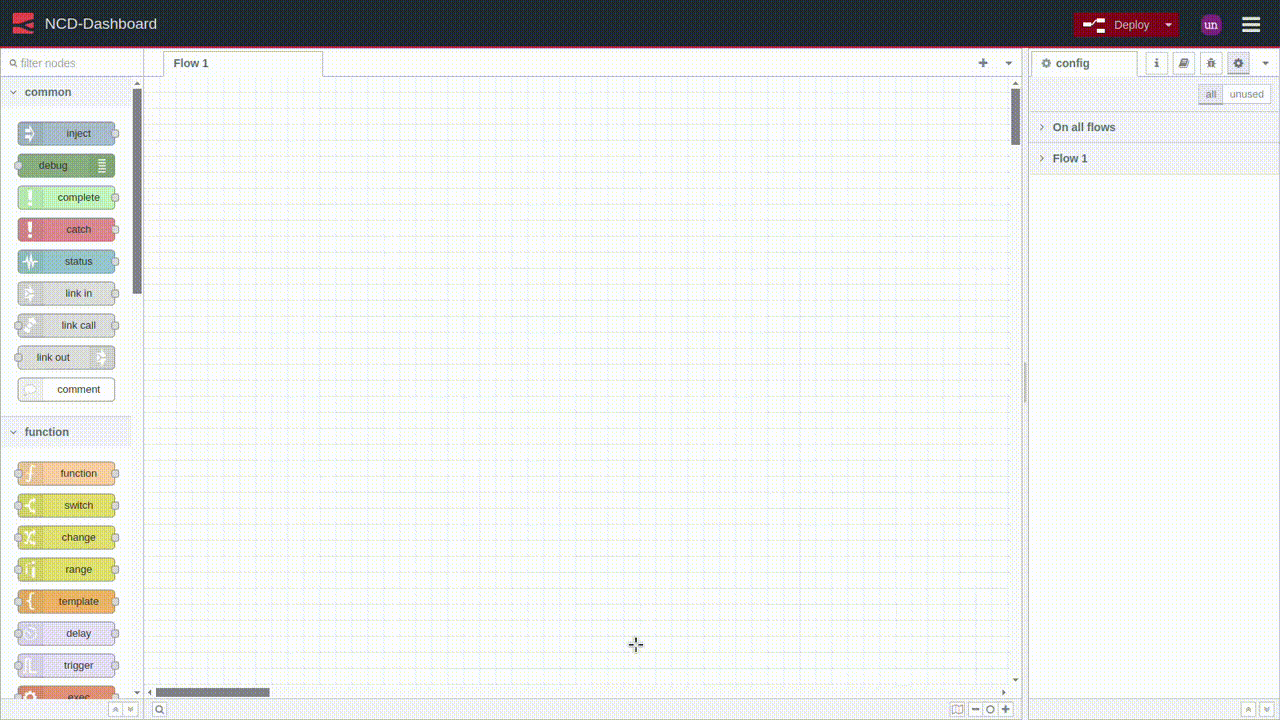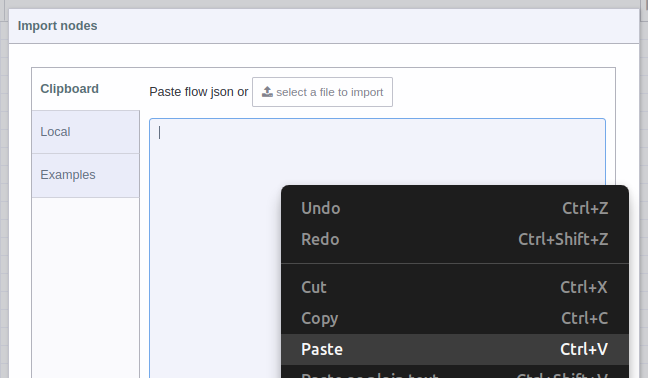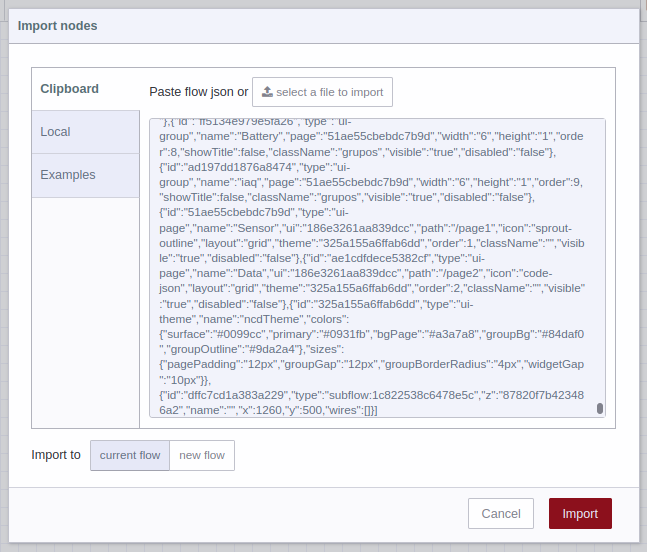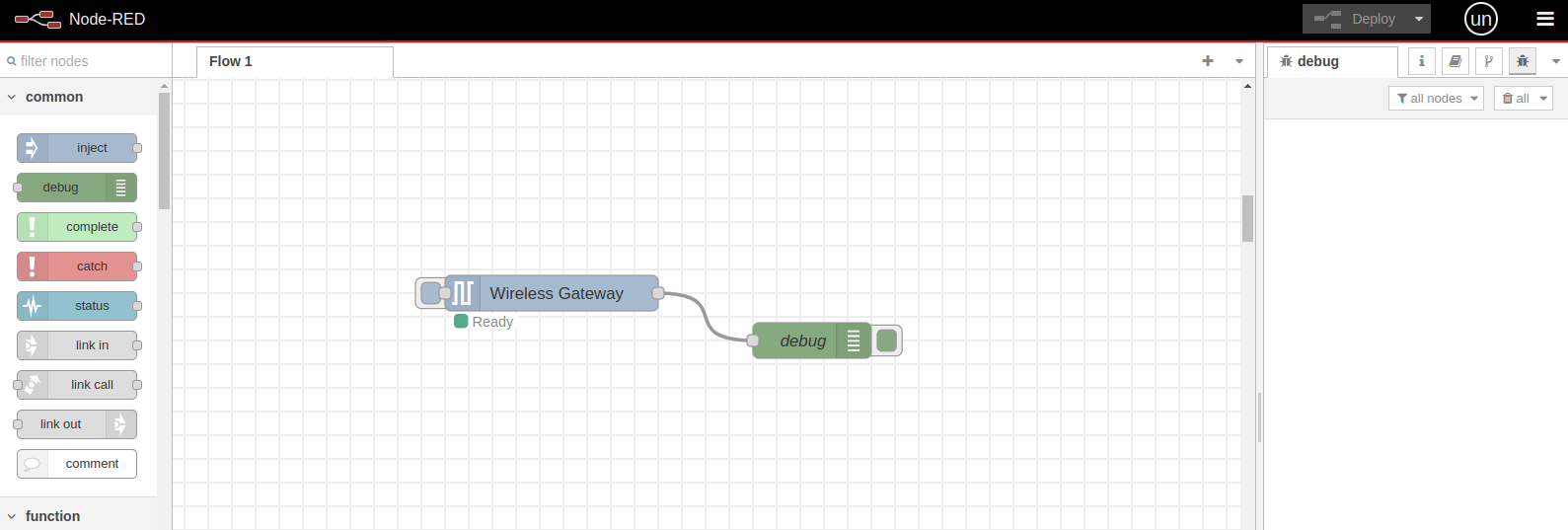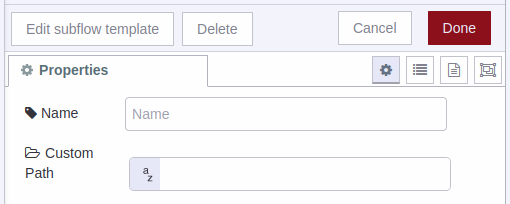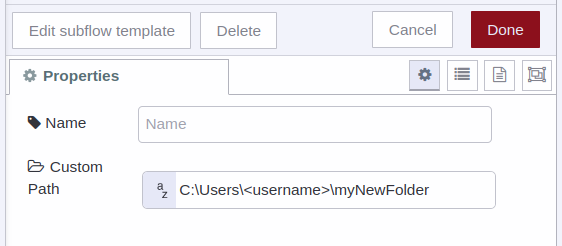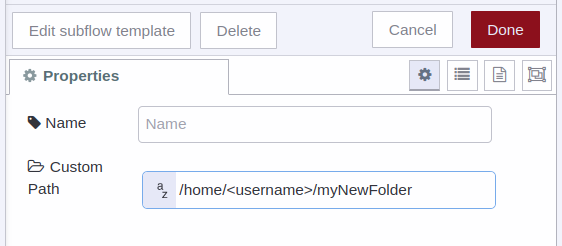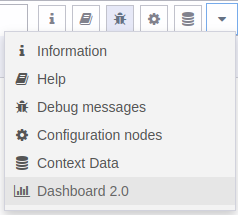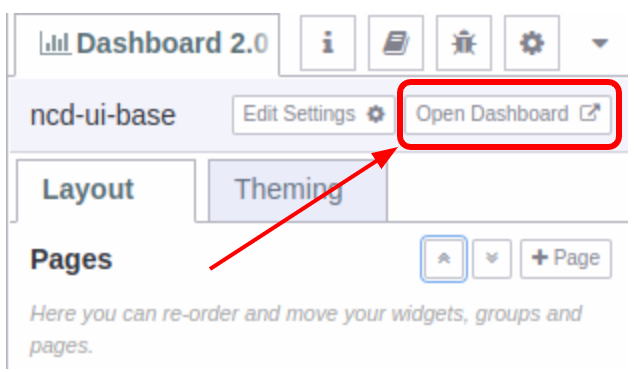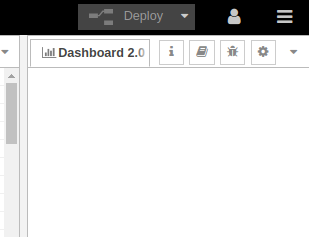Introduction
Smart particulate matter sensors, measuring PM2.5 and PM10, continuously monitor air quality both indoors and outdoors. Using optical technology, they detect particles through light scattering, providing precise measurements. These sensors are connected, transmitting real-time data to cloud platforms and integrating with other systems. Their small size makes them adaptable for diverse settings, from city streets to homes.
In this article, we provide a step-by-step guide on how to integrate the NCD Dashboard into your current Node-RED project, configure it, and install the necessary tools. This dashboard was developed to allow you to monitor the variables from NCD sensors in real-time, manage NCD devices, and store the value of each field variable locally.
Industrial IoT Wireless Particulate Matter Sensor
Industrial IoT Wireless Air Quality CO2 Temperature Humidity Particulate Matter Sensor
The device includes temperature and humidity sensors with a 2-mile wireless range, using SPS30 and SHT30 sensors to provide accurate data on air quality and environmental conditions. It measures various particle sizes (PM1.0, PM2.5, PM4.0, PM10.0) and cleans itself after every 256 transmissions. The sensor operates with an extended battery life of up to 10 years, offers compatibility with numerous systems, and is suitable for diverse industrial and consumer applications due to its range, precision, and affordability.
This device features wireless mesh networking with a 2-mile range, transmitting data on CO2 levels, particulate size, temperature, and humidity. It uses CMOSens® and NDIR technologies for precise CO2 detection and includes an advanced humidity and temperature sensor that compensates for external heat. The sensor measures PM1.0, PM2.5, PM4.0, and PM10.0 particles and employs laser scattering technology for accuracy, cleaning itself after every 10 transmissions. Powered by six AA batteries, it offers up to 3 years of battery life, with an option for external power.
Overview
The next image is a visual representation of NCD Dashboard with The Industrial IoT Wireless Air Quality CO2 Temperature Humidity Particulate Matter Sensor and The Industrial IoT Wireless Particulate Matter Sensor. The sensor(s) collect the data of interest from the field elements, and then send the signal via Digi-Mesh to the Enterprise IIoT Gateway or Industrial IoT Wireless Modem, where it is processed by Node-RED and then sent to the NCD-Dashboard for storage and intuitive Real-Time visualization.
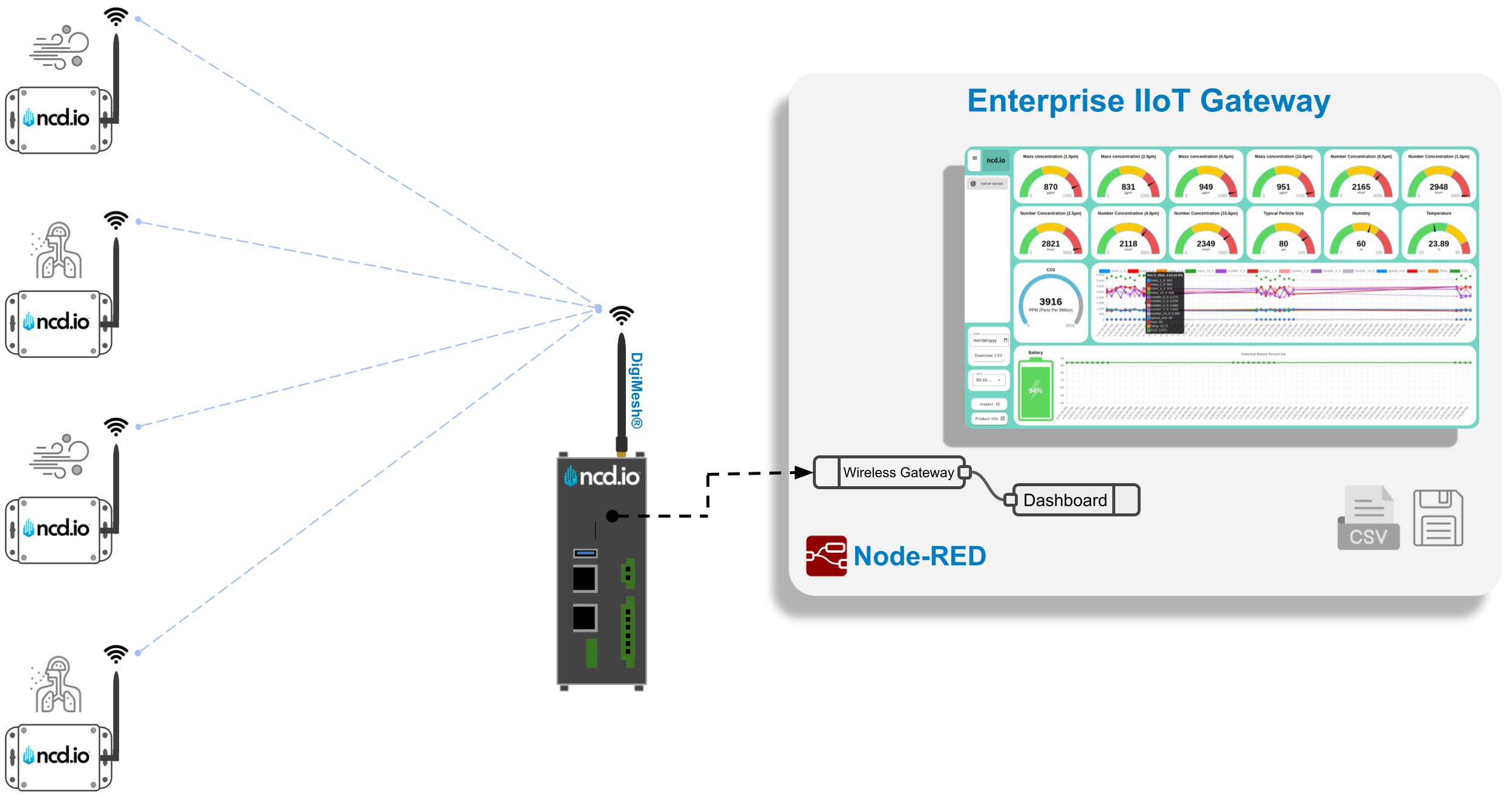
Highlights
Real-Time Data
Real-time display of the variables emitted by the sensor.
- Mass concentration (1.0µm)
- Mass concentration (2.5µm)
- Mass concentration (4.0µm)
- Mass concentration (10.0µm)
- Number Concentration (0.5µm)
- Number Concentration (1.0µm)
- Number Concentration (2.5µm)
- Number Concentration (4.0µm)
- Number Concentration (10.0µm)
- Typical Particle Size
- Humidity
- Temperature.
- CO2 (Air quality)
- Battery level.
Historical Data
Historical data visualization of the values of the variables emitted by the sensor.
Detection by Type
- Industrial IoT Wireless Air Quality CO2 Temperature Humidity Particulate Matter Sensor
- Industrial IoT Wireless Particulate Matter
Data Inspection
Function to inspect from the dashboard the object data coming from the sensor(s).
Local Datalogger
Generation and storage in local (or user-defined) path of CSV file with data from the sensor(s).
Dynamic Sensor Selection via MAC Address
- Dynamic Data Loading: This feature allows your NCD Dashboard to automatically update the displayed information based on user selection.
- Sensor Selection via MAC Address: Users can choose the sensor they want to see data from using a dropdown menu that lists sensors by their unique MAC address.
- Automatic Data Update: Once a sensor is selected, the NCD Dashboard automatically retrieves and displays the relevant data for that specific sensor.
On-Demand Download
- Convenient Data Export: Download sensor data as CSV files directly from your web browser.
- Local File Access Not Required: Download the CSV file to any device within your local network, regardless of where the dashboard is hosted.
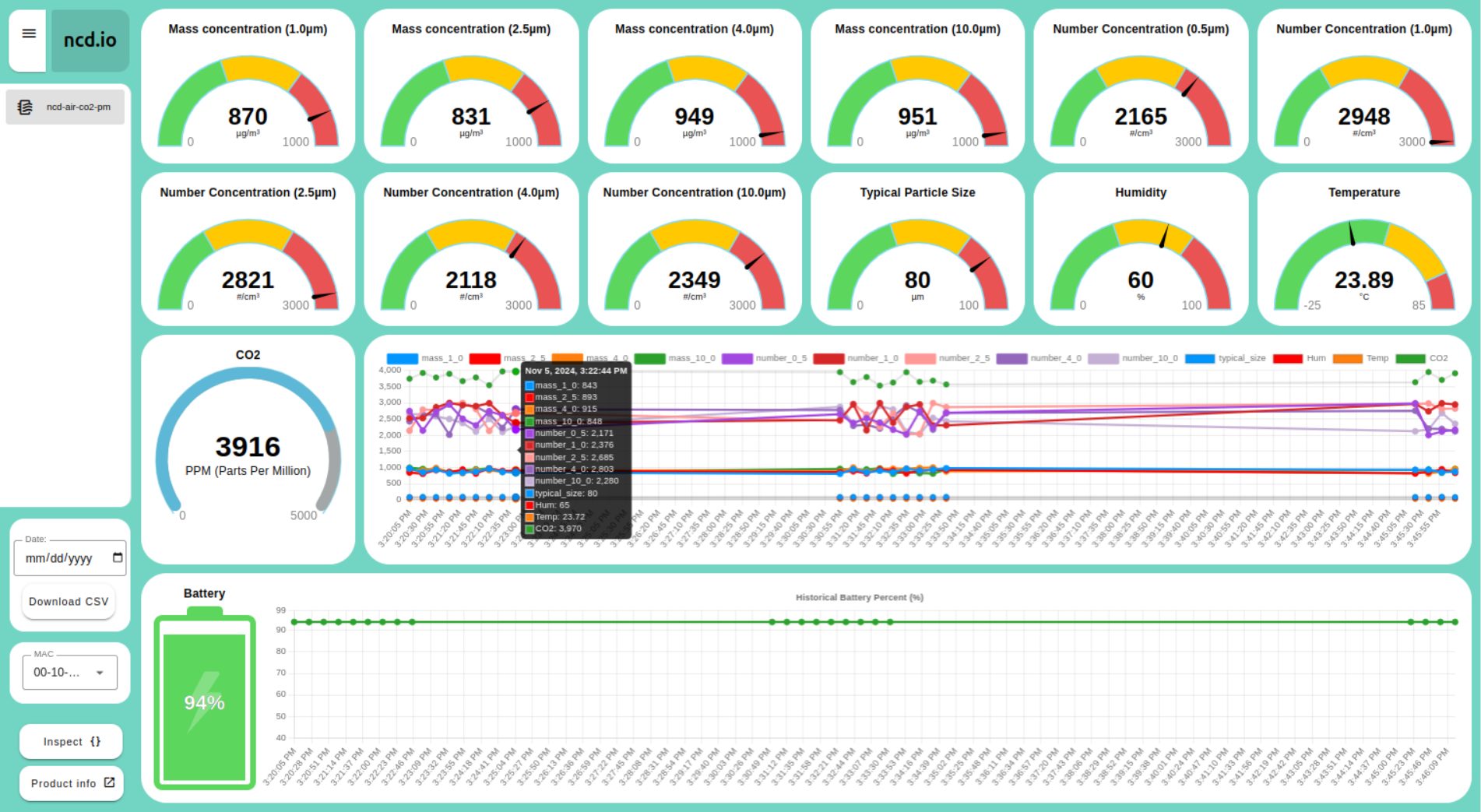
Requirements
In order to follow along with this guide you will need these components:
- An Industrial IoT Wireless Particulate Matter Sensor or Industrial IoT Wireless Air Quality CO2 Temperature Humidity Particulate Matter Sensor.
- An Enterprise Gateway or an Enterprise Gateway Lite
- A computer with WiFi/Ethernet to connect to the Enterprise IIoT Gateway and access to Node-RED.
Before you begin using the NCD-Dashboard, you’ll need to have the following software installed:
- Node-RED (Already installed on Gateway)
- NCD Library (Already installed on Gateway)
- FlowFuse Dashboard 2
NCD Enterprise IIoT Gateway
The Enterprise IIoT Gateway is designed to simplify, streamline, and customize your NCD IIoT installation. It features built-in Node-RED capabilities for no-code integration into new or existing cloud/SCADA systems, web-based security and access management, SSH access to the Debian OS for full customization, as well as VPN and remote management options. This edge computer ensures a seamless deployment experience.
We offer two versions of the Enterprise IIoT Gateway: a standard version with all features, including integrated Wi-Fi, Ethernet, and cellular connectivity, and a Lite version with reduced CPU and RAM capabilities, and no cellular connectivity.
Node-RED
Node-RED is a visual programming tool that provides a browser-based editor for creating applications by connecting predefined functions (nodes). Despite its technical nature, Node-RED offers a user-friendly interface. As an open-source project under the OpenJS Foundation, it is free to use with no subscription fees. You can install and run Node-RED locally on your PC, or, in the case of our Enterprise IIoT Gateway, it comes pre-installed and operates as a service. Node-RED, in conjunction with our Enterprise NCD library, forms a powerful tool for acquiring, managing, configuring, and uploading firmware through an intuitive interface. This combination offers a streamlined approach to optimizing the setup, configuration, and management of NCD sensor data.
Resources
Here you can find a complete getting started guide for accessing Node-RED from the Enterprise IIoT Gateway:
NCD Enterprise Library
This library facilitates communication with and configuration of the NCD Wireless Sensor Line. It can be employed in conjunction with Node-RED to communicate and manage a Wireless Sensor Network using the Node-RED flow-based development tool on any platform. Additionally, as demonstrated, the library acts as an interface for uploading Firmware Updates to NCD Sensors. As mentioned earlier, this library is pre-installed on the Enterprise IIoT Gateway and is ready for immediate deployment.
Installing NCD Library from Node-RED Interface
Step 1.- Access to Node-RED interface, then, inside the Node-RED flow editor you must go to the main menu (top right) and select the “Manage Palette” Option
Step 2.- The “User Settings” window will be displayed, inside “Palette” you must select click on the “Install” tab.
Step 3.- In Search Field enter “@ncd-io/node-red-enterprise-sensors”.
Step 4.- Click the “Install” button to start the installation process, a window will appear at the top of the screen, asking you to confirm the installation.
FlowFuse Dashboard 2

FlowFuse Dashboard 2.0 is an easy to use collection of nodes for Node-RED that allows you to create data-driven Dashboards & data visualizations. Installation procedure is similar to the previous one, FlowFuse’s Node-RED Dashboard 2.0 is also available in the Node-RED Palette Manager.
- Source: https://dashboard.flowfuse.com/
Step 1.- Open the menu in the top-right of Node-RED, then Click “Manage Palette”:
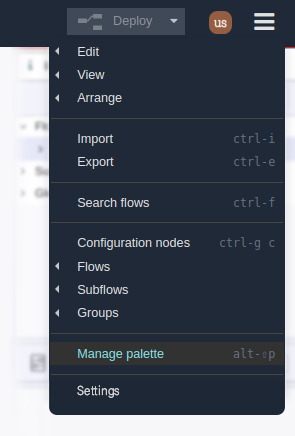
Step 2.- Switch to the “Install” tab, Search “@flowfuse/node-red-dashboard”, Install the package:
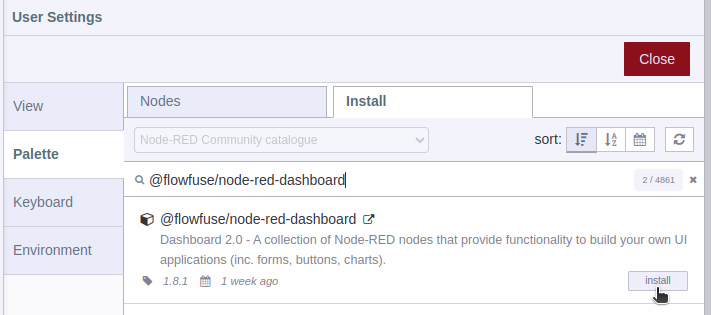
Step 3.- You must confirm the installation by clicking on the Install button in the pop-up window.
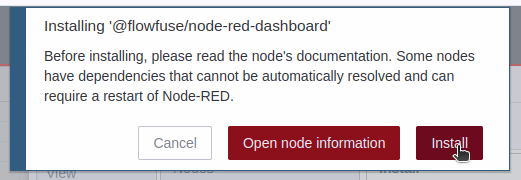
Step 4.- You will see a list of the dashboard 2 nodes that have been installed.
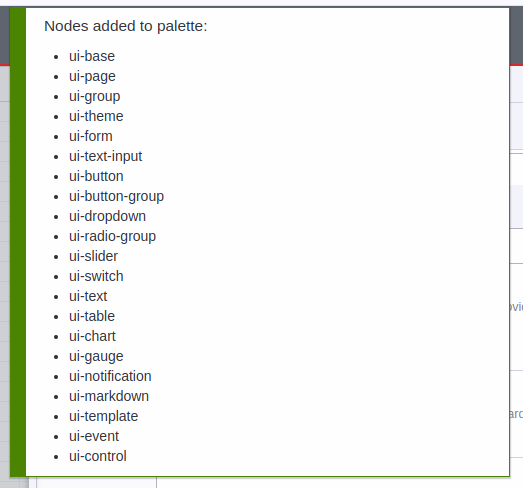
Step 5.- In workspace you can see the available nodes in the nodes palette, as shown in the following image:

Importing
Here you’re ready to import the NCD Dashboard, which is specifically designed and optimized for NCD sensors. The process is straightforward, but be sure to follow these steps carefully:
- Copy the JSON: Locate the NCD Dashboard JSON file.
- Import the JSON: Within Node-RED, use the import function to bring in the copied JSON file.
This will import the NCD Dashboard elements into your Node-RED workspace, allowing you to visualize and interact with your NCD sensor data.
1. Click on the following link to access the NCD Dashboard source code:
6. In the top of the Node-RED editor, you will see information of the NCD-Dashboard you just imported, and automatically you will have the node available inside the node editor, now you can position it inside the editor or workspace by left clicking:
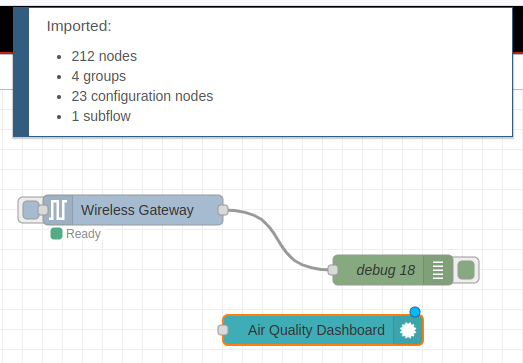
7. You may also notice that the NCD-Dashboard node has been added to the NCD node group in nodes palette.
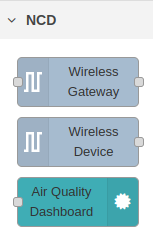
Configuring
This section delves into configuring and connecting nodes within the Node-RED editor. Here, we’ll explore:
- NCD Basic Flow: how to set up NCD Nodes to get data from sensors.
- Node Connections: Learn how to establish connections between your nodes to create the desired data flow.
- Properties and Data Storage Configuration: Discover the property that allows you to define the path where sensor data will be stored within the NCD-Dashboard node.
- NCD Dashboard Node Status: Understand how to utilize the visual node status feature to monitor the operational state of each node.
NCD Basic Flow
When you first access the Node-RED interface from the Enterprise IIoT Gateway, you will see the flow on the right side. This flow consists of two nodes: the Wireless Gateway node and the Debug node.
- Wireless Gateway Node: This node is primarily used for debugging and configuring sensors. It is equipped with a button on the flow that switches the modem between configuration and listening modes. Whenever sensor data is received from any sensor on the network, this node will output a message containing all relevant information, as shown in the example below.
- Debug Node: The Debug node will receive messages from the Wireless Gateway node and display them in the Debug tab.
Node connections
The NCD Dashboard node is designed to work with the output messages from the Wireless Gateway node. Therefore, when importing the NCD Dashboard into your current project, you will need to connect the output of the Wireless Gateway node to the input of the NCD Dashboard node by adding a new connection, as shown in the image on the right
Connecting Multiple Sensors
Each time an NCD sensor sends data to the Wireless Gateway node, and it is connected to an NCD Dashboard node, the Dashboard node stores the sensor’s MAC address. This allows you to have multiple sensors connected to the network and access their data within the dashboard using their MAC address.
When a new sensor sends data, you will automatically see a message indicating that data has been received from a new sensor. The message will display the device’s MAC address, and the sensor will be automatically added to the list of available devices in the Address Dropdown (if it corresponds to a sensor type supported by the current dashboard).
Properties and Data Storage Configuration
If you double left click on the NCD Dashboard node you can open the Properties.
Name: You can assign an identifier to the NCD-Dashboard node. This name only helps distinguish your specific node within the node editor (from other nodes).
Custom Path: By default, this property is set to a fixed location. The NCD-Dashboard retrieves data from your sensor and stores it locally within Node-RED.
Data Storage: The NCD-Dashboard automatically saves the generated CSV files from the sensor(s) within the Node-RED folder.
- Linux (Enterprise IIoT Gateway): $HOME/.node-red/log
- Windows: $HOMEPATH/.node-red/log
NCD Dashboard Node Status
The NCD Dashboard nodes are designed to provide visual feedback on their operational state. This status can vary depending on the node’s input data or configuration. Here are some common scenarios you might encounter:
1. If the path you enter is correct, or if you leave the property field blank (using the default path), you should see a “Saving data” status when new sensor data arrives at the node input, indicating successful storage.

2. It’s important to assign a valid route. If the NCD-Dashboard detects an invalid route, it will display a “Path error” message.

3. If you connect a different type of NCD sensor, you will see the “Type error message”.

Accessing NCD Dashboard
After successfully configuring and connecting your nodes, the next step is to access the user interface. This is where the NCD Dashboard elements, such as gauges, charts, and buttons, are displayed.
Features
In the next section, we’ll delve into the NCD Dashboard elements and their characteristics.
Main Gauges
CO2 Gauge
The gauge for the CO2 variable value is dynamic and is only active for the Industrial IoT Wireless Air Quality CO2 Temperature Humidity Particulate Matter Sensor.

Main chart
In the main chart, you can view the historical values of each variable emitted by the sensor. This chart records or locally loads the last 20 values received from the sensor. It is possible to enable or disable each variable individually by clicking on the variable identifier located at the top of the chart.
Battery Status
Main menu
This menu facilitates switching between different NCD-Dashboards within the user interface (UI). This functionality is particularly useful if you have configured multiple NCD Dashboards to monitor various types of sensors or processes.


DatePicker & Datalogger
The NCD Dashboard allows you to directly download locally stored CSV files containing historical data from your NCD Sensors through your web browser.
Step 1.- To display the date picker you must click on the icon on the right side of the “Date:” box.
Step 2.- Then select the date of interest:
Locate the download section in the bottom left corner. It features two fields:
- Date: Enter the desired date (format: mm/dd/yyyy) to download the corresponding CSV file containing historical sensor data for that specific day.
- Download CSV Button: Click this button to initiate the download of the CSV file directly to your web browser.
Date Format:
- mm: Represents the month (e.g., 01 for January, 12 for December).
- dd: Represents the day of the month (e.g., 01 for the first, 31 for the last day of the month).
- yyyy: Represents the four-digit year.
Step 3.- Then click on the “Download CSV” button. If the NCD-Dashboard finds the file for that date, you should be able to see the download begin (indicated by your web browser’s download icon) as shown in image.
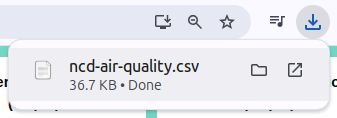
Step 4.- You can open the downloaded CSV file. The content will be similar to the following:

Address Dropdown
Inspect
Product Info
Summary
This article provided a step-by-step guide on how to import an NCD Dashboard for two types of sensors: the Industrial IoT Wireless Particulate Matter Sensor and the Industrial IoT Wireless Air Quality CO2 Temperature Humidity Particulate Matter Sensor. The main features of this dashboard were presented, along with each of the available elements. This dashboard is designed to simplify the integration of NCD sensors with a graphical interface, enabling the monitoring of field variables emitted by the sensor and providing a CSV record of each value.
Thank you, NCD Team




